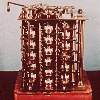Skip over navigation

Or search by topic
Number and algebra
Geometry and measure
Probability and statistics
Working mathematically
Advanced mathematics
For younger learners
Babylon Numbers
Age 11 to 18
Challenge Level 





- Problem
- Getting Started
- Student Solutions
- Teachers' Resources
Why do this problem ?
This short task gives an interesting historical context and a
way to understand the difference between hypothesis and conjecture;
convincing argument and proof. It will encourage mathematical
creativity and also put students in a situation in which there is
no obvious answer or way forward.
Whilst the number skills required are basic, the investigative
aspect of the problem would make an interesting challenge for any
students who want to develop problem solving skills.
Possible approach
Discuss the problem. Does anyone have any suggestions? Can
others test the suggestions? You will need to use calculators.
Students will want to write out the tables and then calculate sums,
differences, products and other combinations of the values until
they spot a possible pattern.
Key questions
- Describe what you see in the numbers
- What ways of linking numbers do we know?
- Are there any obvious rows in the table to look at first?
- If there are mistakes in four rows, how many rows do we need to test before rejecting a hypothesis?
Possible extension
If we find a rule which explains all but the 4 erroneous rows
of numbers, does that prove that our rule is the one that the
person making the table was thinking of at the time? For what sorts
of reasons might a Babylonian have been writing down mathematics?
What sort of mathematics might they have needed to know
about?
Possible support
Some students might initially find it difficult to suggest a
line of enquiry and then to test it.
Start the group off with this statement 'My hypothesis is that
the third column is the sum of the previous two columns' and then
ask the class to test out this hypothesis.
For example, is one row the sum of the other two? (No, but it
starts a chain of enquiry)
You may also like
Divided Differences
When in 1821 Charles Babbage invented the `Difference Engine' it was intended to take over the work of making mathematical tables by the techniques described in this article.

